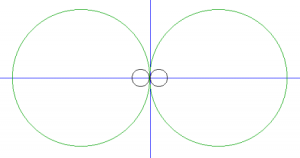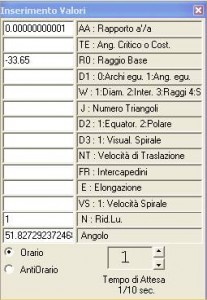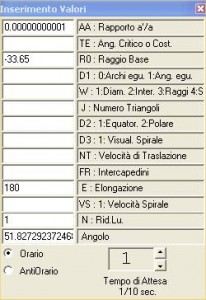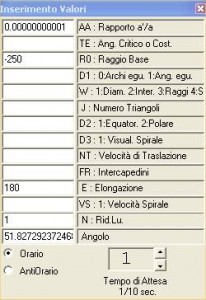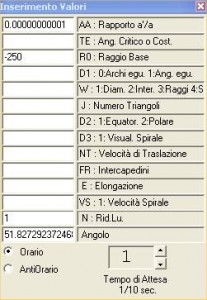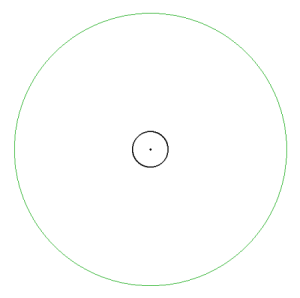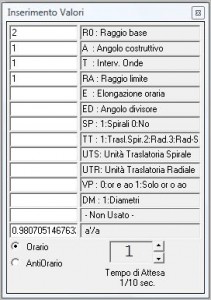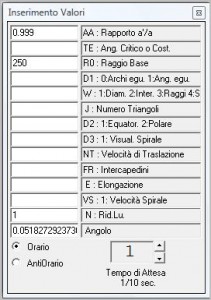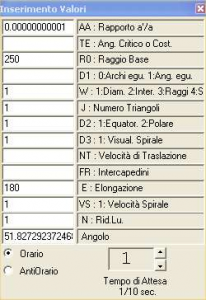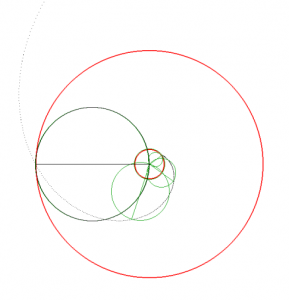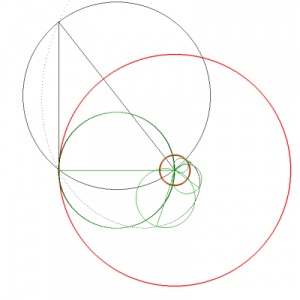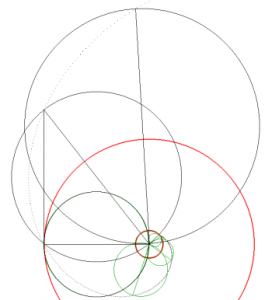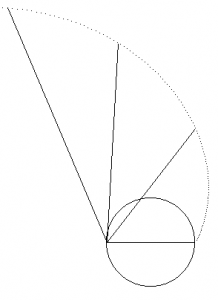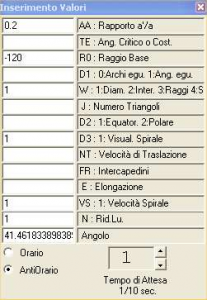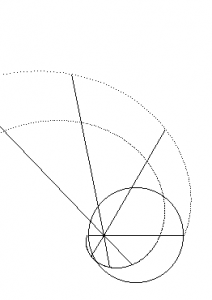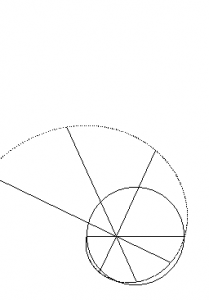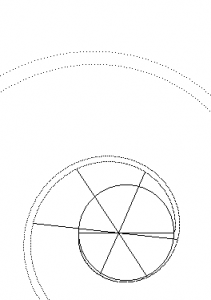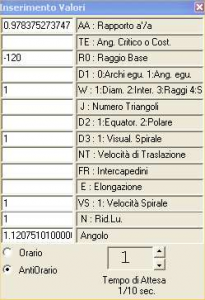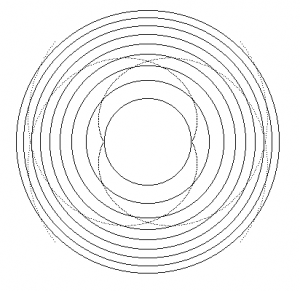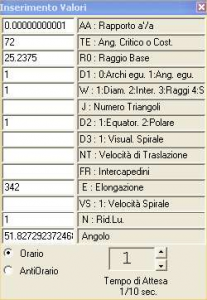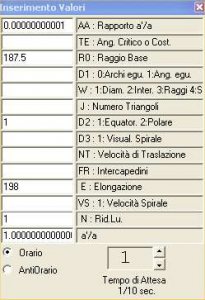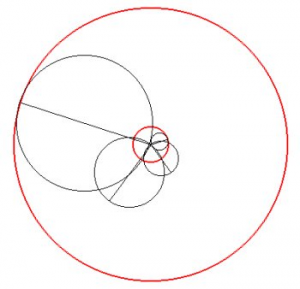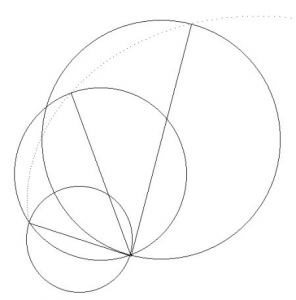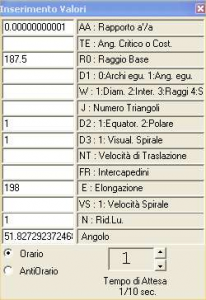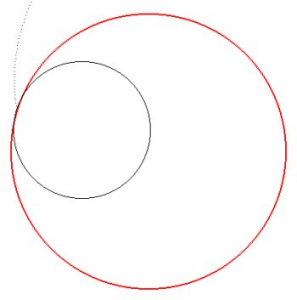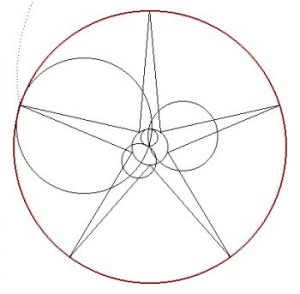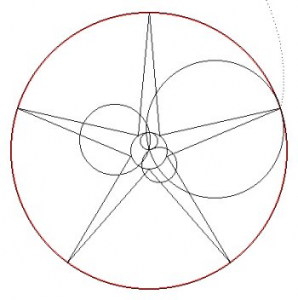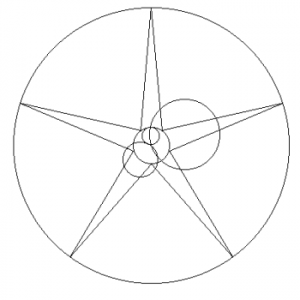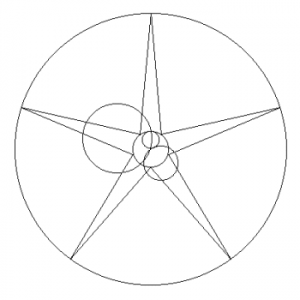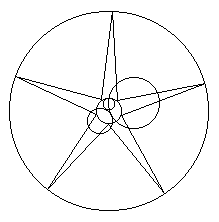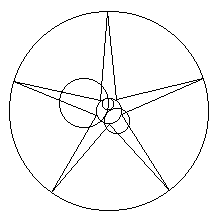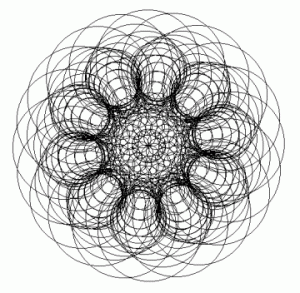Chapter 6.1 The elementary particle: the photon (absolute atom, graviton: “The Universe is light”).
GEOMETRIC STRUCTURE – KINETIC PROPERTIES – THE UNDULATORY FUNCTION
§ 1. What we are going to describe is the geometric outline of an infinitesimal mechanism, producing elementary gravitational waves, of which we have studied in the previous section 3 the mathematical and functional law of progressive composition and consequent extension, from the subatomic fields to those of the galactic systems.
Structure and operation of the final particle of the physical universe have their own reason in themselves, not being possible to lead them back, for the same definition of “extremum physicum”, to nothing else that is physically analyzable.
The description that we give is not born, obviously, from our fantasy, but it is the result of a precise process towards the root of the phenomena: a process coming rigorously from a physics and at the same time logical-mathematical point of view, that is condensed in the cosmological equation. This is completely natural for a reasoning mind, even if it is instead stranger to the supreme postulate of programmatic ignorance, that it is the “indeterminacy principle”.
§ 2. Formal geometry of the photonic corpuscle must be inserted in an ideal container represented by a geometric external and internal double-torus: of it we see the polar section in fig.1 and the equatorial one in fig.2.
We now supply the constructive procedure of fig.1 with OLOPOIEMA. PROPAGAZIONE, bringing back the Input for the Table INSERIMENTO VALORI ; then follow the instructions written at the bottom of the same Table.
Continue with the instructions of the Tables below, without un-implementation of the Subprograms previously used, otherwise the images will be removed from the screen.
.
In order to construct the fig.2, the following three passages are needed using three different Subprograms, as indicated at the bottom of the Tables INSERIMENTO VALORI.
§ 3. Let us begin with the actual size of the container that we have just drawn. In the two figures, the real proportions are maintained between the central and outer torus (torus: the surface generated by revolving a circle around a line of its plan that does not intersect, in our case around a tangent line).
Let us say first that, in the linear measurements of the subatomic world, physicists flirt using as unit – related to the macrocosm and to be multiplied by the negative powers of 10 – the centimeter (cm) or even the meter (m), almost as if this was the insignia of their competence in comparison to the limitations of the profane, whom in comparison with the small things like referring to the millimeter (mm). For this reason, in hate of all the guilds of “experts”, we will use in our measurements the reference to the millimeter. For example, the measure of 1 fermi is of course still the same, if it is designated as 10-13cm or as 10-12mm, but in the common mental perception of the very small it is of more immediate efficiency the expression of a thousandth of a billionth of mm than a ten-thousandth of a billionth of cm.
§ 4. Let us denote by the Greek letter Δ (delta large) the diameter of the outer torus figs.1 and 2. With an indirect process, starting from the known value of the speed of light c = 300,000 km / s, we have come to determine the upper limit of Δ as 10-22mm. The actual value is, moreover, very close to this limit, that we assume, therefore, as our fixed reference in further determinations of the measure of particle photon.
Let us first realize the proportional meaning of such a measure with respect to others in comparison. If we set as 1 Å (Ångström), that is 10-7mm, the diameter of an atom and as 1 fm (fermi), that is 10-12mm, that of a proton, the proton diameter will be 100,000 times smaller than the atomic diameter and 10 billions of times larger than the photonic diameter Δ.
A better idea of the proportions will come by imagining to enlarge the diameter of the proton to make up a sphere of the size of a kilometer. The atom will then be a sphere with a diameter of 100,000 km, almost as big as the planet Saturn (average diameter of 114,000 km), while the diameter of the photonic torus would measure only one ten-thousandth of a mm.
§ 5. In a world of such extreme smallness we are guided by the same cosmological equation with which we have now walked the streets of the macrocosmic universe. This universe could not be what is in fact in all its forms and structures, if the last particle that constitutes its foundation was different from the one we will describe mathematically. With a necessarily gradual approach the geometric and kinetic-dynamic characteristics of the elementary particle shown step-by-step for the individual elements, will converge at the end in an animated picture extraordinarily surprising.
Let us call by the Greek letter τ (tau) an very small infinitesimal, of which we will later give the value, corresponding to 1 / 5 of the length of the photon spin. Let δ (small delta) = 0.5 Δ (photon radius, the external radius of the torus), ε (epsilon) = 0.5 δ = 0.25 Δ (radius of an “emissive chamber”, as we will explain shortly), υ (y.) = 0.0673 Δ (radius of the inner torus or diameter of an “wavegenetic chamber”).
§ 6. With this data proportionately inserted in OLOPOIEMA, PROPAGAZIONE verde (green) (Fig. 3), by clicking 4 times on AVANTI, and then, through the STOP, in PROPAGAZIONE nero(black) (Fig. 4), by clicking only once on AVANTI, you get Fig. 5 . By clicking once more AVANTI Figures 6 and 7 will be obtained.
Figure 5 shows the equatorial section of the photonic double torus (the polar section we have seen in Fig.1), visually rotating clockwise around its central axis, with the South over the screen and the North below. Attached to the photonic rotation the “gestation” of a spherical wave is represented, which moves from a spherical “wavegenetic chamber”, contained in the internal torus, and that is fed, “blown” along its diameter and forced to rotate with the same angular velocity of the photonic structure.
The figure shows the development of the wave in three successive τ, out of the five of the total duration of rotation, in each of which the wave diameter describes an angle of 72 °. At the end of the total length of 216 ° the wave occupies entirely an “emissive chamber”, which is also spherical, internally tangent to the photonic horizon, i.e. the maximum circumference of the outer torus. At this moment it is separated from the photonic structure that has alimented it: the photon-particle follows its translational path in the space and the wave is left alone to rotate indefinitely and to propagate around the absolute point of the space corresponding to the position of the photonic center in the emission instant.
§ 7. We must now pay the utmost attention to the analysis of the resulting process, shown in Figs.6 and 7. These show inappropriately, but only for ease of understanding, the two phases of the phenomenon still together: the one preceding the emission and the one, instead, that follows it and has a different mode.
Following the moment of the emission, as shown in the preceding paragraph, the photonic structure, represented by the red tori, should have moved away from the just emitted wave: which does not appear in the two drawings. Figure 6 shows the absolute position in space of the emitted wave after a τ following the emission, and fig.7 its position after the first and second τ following the emission. At this point, a complex comparison between the two above-mentioned phases of the emission process is requested, which makes it useful the impropriety of the graphic detected above.
§ 8. During the gestation of the wave inside the photonic horizon, the rotating extreme of the wave diameter has two movements: one circular and one radial, which make it move along the logarithmic spiral in drawn in figs.5, 6 and 7 and regulated by the cosmological equation adjusted for the value to a’/a = 0 (absence of the second source a’). Of this spiral, as for each logarithmic, the program OLOPOIEMA calculates the acute angle Z that a tangent forms with a radius at the point of tangency. It always appears in the window VISUALIZZA VALORI and it is, in our case, 61.987623 °.
Let us call B the above-mentioned rotating extreme and calculate the three speeds of its motion with the parallelogram composes them. At the emission moment, the speed of the circular motion Vcir is:
Vcir = 2π δ / (5τ)
For a reason that we will see, we should express it in terms of ε instead of δ:
Vcir = 4π ε / (5τ) = 0.8 π ε / τ
We imply for these wave speed values the expression ε / τ, of which we will soon determine the meaning. We will therefore have:
Vcir = 2.513274
The velocities parallelogram is, in this case, a rectangle that has sides Vcir and radial velocity Vrad, while the diagonal is the spiral speed Vspi, Z being the acute angle between Vspi and Vrad.
It follows that at moment of emission:
Vrad = Vcir / tanZ = 1,33702797
Vspi = Vcir / sinZ = 2,8467859
§ 9. The values now specified are the maximum speed values reached by the wave point B in its centrifugal motion inside the photon, the instant it touched the photonic horizon. After the wave release and detachment from the photonic center, the three values are settled in a definitive way, so that B will follow the logarithmic spiral with a constant Vspi, and the same goes for the other two, covering linearly equal arcs in equal times.
In the first infinitesimal τ following the emission, the arc path is that of fig.6 that circumscribes the triangle building the spiral: the triangle, ie, which acute angle with vertex in the photonic center is arccosφ.
Since, in the logarithmic spiral, linearly equal arcs correspond to equal radial increments, namely Vrad is constant, we can from this, which we know from the cosmological equation, derive the other two constant velocities of B after emission.
In the emitted photonic wave the radial increment is δφ: in Figure 6 it is the segment of the hypotenuse external to the photonic horizon. As a function of ε such an increment is 2εφ, ie 2*0.618034ε = 1.236068ε. By eliminating, as mentioned above, the notation ε / τ, we have, after emission:
Vrad = 2φ = 1.236068
Vcir = Vrad tanZ = 2.32349
Vspi = Vrad / 2.63182 cosZ
§ 10. By comparing the values of the three speeds at the time of the emission (§ 8) and after the emission (§ 9), we find that all three suffer, as is natural, from the detachment of the wave from the photon center alimenting a sharp, although slight, decrease, assuming a character of final constancy during the subsequent wave propagation in space.
Here is the summary before and after the emission:
Vcir = 2.513274, 2.32349
Vrad = 1.33702797, 1.236068
Vspi = 2.8467859, 2.63182
§ 11. We must now define the notation ε / τ, that we have so far implied, which is needed to confer a concrete meaning to the values of wave speeds.
We recall that the two extremes of the diameter D of a primitive wave run, through the following propagation, two logarithmic spirals propagate at a constant speed, higher on the smaller source side and lower on the greater source side.
In the photon propagation (and, roughly, in the composite fundamental, that resembles it) there is only one propagation spiral, because the centroid coincides with an endpoint of D, i.e. the greater source, which is the same photonic center, and the smaller is absent (or very small, in the composite fundamental propagation).
Let us deal with the spiral followed from the extreme B (§ 8) of D corresponding to the minor source (theoretical in the photon), the distance covered at higher speed. This speed, always constant, is governed by a universal formula, which makes it decrease as the ratio a’/a increases from zero, in the photon (and, roughly, in the fundamental propagation), up to 1, in the case of equal intensity.
Let us call Vsf the maximum value of Vspi given at the end of § 9, precisely because of the constant speed of B in the photonic propagation after emission, and Vsg the general value for any propagation, primitive (photonic) or composite. It will then be obtained, completing the above implied notation:
Vsf = 2,63182ε /τ
Vsg = [1 + (2,63182 – 1)(a – a’) /a] ε /τ
This formula says that Vsg varies from Vsf for a’= 0, precisely in the photon propagation (where a’/a = 0), up to ε/τ for a’= a in the case of equal intensity (where a’/a = 1).
§ 12. Let us now clarify the meaning of the notation added to the velocity values. It is the limit of the phenomenon graphically illustrated in Figures 8 to 11, where one changes only the value a’/a, from the zero of the photon propagation toward the case of equal intensity, where the ratio is 1. We have eliminated the design of the wave propagation (with the zeroing of D2), leaving only the diameters of its successive positions at intervals of time always equal. The minus sign in R0 is a conventional expedient to assign the given value to the diameter of the wave, which remains constant, rather than to the radius of the spiral. By clicking the value of AA one can read at the bottom the constructive angle value corresponding to the ratio a’/a and each drawing is obtained by clicking AVANTI 4 times.
In the four figures the length of the rectified spiral arcs is proportional to the spiral speed Vsg governed by the formula of the preceding paragraph and it is read in the window VISUALIZZA VALORI as second value of the line LU. The unit of measurement is the radius of the primitive wave (R0/2). Here are the four respective values, adding to each one of them the notation in question:
2.631824ε /τ (cfr. Vsf nel § 11)
2.305459ε /τ
1.944574ε /τ
1.489547ε /τ
These values tend towards 1ε/τ as a’/a tends to 1 and the constructive angle to zero, that is, towards the case of equal intensity. As already stated, they are to be read on the spiral relative to the smaller source, i.e. on the one of the two traveled at higher speed (§ 11).
§ 13. It is very interesting to observe the graphical behavior of the two spirals in relation to a’/a and the constructive angle, which appears at the bottom of the window.
There is only one spiral in the photon propagation (Fig. 8 and § 11). In other cases the spirals are two, but for a constructive angle of exactly 30 degrees, the major source spiral is superimposed exactly to that of the minor source, forming with it a unique curve: it is clearly seen in Figure 10. If the constructive angle is greater than 30°, the spiral of the major source (from the side of the minor radius) runs inside the other (Fig. 9); if that angle is less than 30°, the reverse is true (fig.11). This feature has great importance in natural phenomena.
It should be said, at this point, that the wave speed cannot in any way be determined experimentally, but only with our logical-mathematical method, because all the observed motions – even rotational ones – are to be referred only to corpuscular phenomena, which instrumental envelopes often assume, especially in the microcosmos, wave aspects. Gravitational waves, as we have repeatedly emphasized, are the intermaterial support of events and structures and are not intercepted by any means. The ridiculous instrumentation set-up for this purpose by contemporary physics would give a sure sign of uptake of gravitational waves only if those physicists decided to have them fall on their heads.
That said, we can finally clarify the relationship between the speeds we’re talking about and the maximum speed of photon particles in their translational motions through space: the so-called speed of light in vacuum.
§ 14. We said that the limit value of a’/a in the transition from eccentricity to concentricity is not that absolute equal intensity, i.e. 1, because in this case the logarithmic spiral, with a constructive angle equal to zero and Z = 90 °, by degenerating in a circle would not allow any more propagation. At the actual limit (a’/a = 0.978375273747) the formula of Vsg from § 11 gives an arc of logarithmic curve of 1.035288, equal to the arc of the Archimedes spiral that it replaces (that we measure with another program) between the first two wavefronts of the concentric curve proportionally built (fig. 12). These two fronts are two positions of the spherical concentric wave increased by an equal surface (radii proportional to the square roots of the integers): positions separated by the same infinitesimal τ between subsequent photon wave and that we have indicated as equal to 1/5 of the time of the photon rotation.
All this means that the actual limit of the wave speed along the logarithmic spiral of the eccentric propagation – the spiral of the lower source – from the photon Vsf to the equal intensity, is slightly higher than ε/τ, and being precisely 1.035288/τ.
§ 15. We have previously described the function of the eccentric propagation as “road network”, attractive and whirling, of the translational motions of bodies and particles through space, and we have seen as the ether exerts at the same time a very slight drag force to those same motions, erroneously read by current physics as “relativistic increase in mass” and the real cause, however, of the particle speed limit represented by c and approximately equal to 300,000 km/s.
It is now clear that the wave speeds along the propagation logarithmic spiral (the spiral of the minor source), by decreasing with the increase of a’/a towards the equal intensity up to the limit value given in the preceding paragraph, decrease with the increasing propagation curvature the translational motions gravitational acceleration, which speed cannot exceed the minimum wave speed. It follows that the two theoretical limits coincide, that is, ε/τ is, at the same time, the lower limit towards which wave speeds along the logarithmic curve tend and the top limit of the translational speeds of bodies in space.
Ultimately, we can conclude that ε/τ = c.
§ 16. Since we have assigned to ε the value of 0.25Δ, or 0.25*10-22mm (§ § 4-5), one can determine also the value of τ, the smallest time dimension, with the proportion
ε: 3*1011mm = τ: s, from which
τ = ε s / (3 * 1011) = (0.25 / 3) * 10-33s = 0.8333…*10-34s
The duration of a photon rotation is, therefore,
5τ = 4.1666…*10-34s
The speed of rotation along the photon horizon (§ 8) is
Vcir = 2.513274 ε/τ or Vcir = 2.513274 c
Consequently, all speeds in the prospectus of § 10 are coefficients of c.
If, going back to Fig.5, we imagine that the photon particle moves in the “empty” space along its axis (in the figure, perpendicular to the screen of the photon center), we have, from all of the above, that it runs at its own translational speed c a distance equal to three-quarters of its diameter during the three-fifths of its rotation therein represented, i.e. in the time
3τ = 2.5 * 10-34s
it will travel a distance equal to its diameter during four-fifths of rotation, i.e.
4τ = 3.3333… * 10-34s
§ 17. Now let us read § 6, and refer it to Fig.13, which reproduces Fig.5 of that paragraph, only slightly scaled down and rotated clockwise of 18˚. To build it, we use PROPAGAZIONE (2 NERO) with the values of Fig.13-A, by clicking AVANTI four times, and then, by passing through STOP, PROPAGAZIONE (2 NERO), with the values of Fig.13-B, clicking only once.
Let us give a name to the four wave positions inside the photon horizon, up to the release. They are spaced by an angle of 72 ° and a time of 1τ. From birth onwards in the wavegenetic chamber, they will be called the “Risveglio (Awakening)” (Rs), “Veglia 1 (Wake 1)” (V1), “Veglia 2 (Wake 2)” (V2), “Emissione (Release)” (Em), respectively.
A fifth angular position, without a wave, should be imagined at 72 ° after Em, always clockwise, that is at half angular distance between Em and Rs, and will be called “Riposo (Rest)” (Rp). As it is now oriented, the figure presents Rp at 270° clockwise (or 90° counter-clockwise).
§ 18. The Em wave is from that moment independent of the photon (red) in transfer motion, so it disappears from fig.14. In the latter, three positions are drawn from the same wave at the moment of the release, separated by two τ as in Fig.7: The spherical wave rotates endlessly around the release absolute point, as is said in § § 6-7, by maintaining forever unchanged in space its equatorial plane, here represented by the plane of the screen. The arches traveled from the extreme of the diameter along the logarithmic spiral are linearly equal.
Let us go back in fig.15 to the final moment of fig.13: the three wave positions were therefore eliminated before the release.
The photon horizon at that time seems to contain only the wave to be released, but in reality, as it will be seen immediately by the subsequent figs.16 and 17, it contains four different ones, one for each of the phases indicated in the preceding paragraph, and each fed by a different “arm” of the photon structure. This is pentaradial, like a starfish: the fifth arm is in the phase of Rp.
§ 19. Before describing the characteristics of figs.16 and 17 and the subsequent implications, we must make a preliminary observation: we have defined not by chance “unimaginable” the functional mechanism of the elementary particle that we are describing.
This literally means, that if it were not true, we – like everyone else – we could not absolutely “picture it”, because it belongs to a conceptual level, many orders of magnitude higher than any possible imagination or fantasy. Our merit, which is to have discovered it in the fundamental law of nature, is far below the intelligence that we should possess in order to “invent it”.
This statement, which readers can verify with their own judgment, is given, in other words, as an “ontological proof” of the reality of what we are going to describe. A reality that, however, regardless of this proof, is shown by the general context of the discourse we have followed on the structuring of the universe in its entirety and context: if the final particle was not as we describe it, the universe could not be what it is.
§ 20. Let us go back to the discussion of § 18. Figure 16 already has the entire photon equatorial geometry seen from the south pole of the photon rotation (§ 6), supposedly clockwise. Figure17 gives the north view, with counterclockwise rotation. We will give later instructions for the construction of the two figures.
The already used the terms “wavegenetic chamber” and “release chamber” refer to ideal spheres containing a wave in formation, at the lower end of an arm, inside the internal torus, and a wave to be released, between the center and the photon horizon, respectively. There are, therefore, five wavegenetic chambers in the internal torus and five release chambers in the outer one, geometrically perfect and therefore not drawn.
The photon of fig.16 is – so to speak – photographed at the moment when, simultaneously, a wave in Rs is born in the chamber relevant to the northern arm (according to the compass rose) and another in Em is emitted from the north-western arm. A third wave in V1 is fed from the south-western arm and a fourth in V2 from the north-eastern arm. The south-eastern arm is in Rp. In fig.17 genetic phases are viewed from the North photon axis (do not confuse with previous conventional directions of the compass) and appear reversed, because now the rotation of the photon is counterclockwise.
The instantaneous contemporaneity of the release and the awakening of two waves means that, during gestation, the waves actually fed by the arms are three and not four, as it would appear from the two figures. We will see soon clearly development of the entire process: now let us just observe that the five phases follow one another from arm to arm according to the tracking of a five-pointed star, or starry pentagon, and in a retrograde fashion with respect to the photon direction of rotation. It is important, for fully understanding the following discussion, to check this property in both figures.
§ 21. In both figures the photon direction of rotation – clockwise in fig.16 and counterclockwise in the other – is indicated by the spiral that the emitted wave will follow into space. The birth of a wave, that is the Rs phase, in the wavegenetic chamber, happens in the arm that precedes in the rotation the one that simultaneously emits its own wave. The emitted wave, therefore, drawn in the two figures for a better understanding of the phases, disappears in reality from the photon interior at the same moment of the wave appearance in Rs, as we have said, while it continues its propagation in free space as explained in § 18 and in its fig.14. Figures 18 and 19 represent the real situation of the photon interior at the time of the detachment and autonomy of the wave in Em from its pulse center.
In both figures two out of three arms are without a wave, as we had predicted in the previous paragraph, but at different times.
We have now reached the final step of our process to the heart of infinitesimal matter: it will be necessary to pay close attention to the details of what we are about to speak, in which the “inconceivable” perfection – we repeat – of the photon particle wave dynamics is revealed, which is the ultimate and only foundation of universal laws, root at the same time of unity and infinite complexity of the universe.
The northwest arm of fig.18, which has just issued its wave, is at the beginning of a period of sleep (“sonno”) lasting 2τ and two-fifths of clockwise rotation (144°), until the awakening of a new wave at its base in the north-east direction. Let us call SO (from “sonno”=”sleep”) that period, of which the Rp phase represents the median, crossed by the arm on the north direction. After overcoming SO, the arm enters a remaining period of wakefulness lasting 3τ and three-fifths of rotation (216°), passing through the V1 and V2 phases of the wave that it feeds, up to the release of such wave in the same north west direction of the previous issue. Let us call VE (“veglia”=”wake”) the period of activity. The south-east arm, however, is at half of its SO, i.e. in the Rp phase, having released its own wave in the north-east direction, and will have its Rs after 1τ and a fifth of rotation (72 °) in the south –west direction.
The other three arms are in the respective VE period, namely: the north one in Rs will emit the wave originated in the south-west direction, after a rotation of 216 °, passing through V1 and V2 and then continuing in a SO condition up to a new Rs, which will happen in the same north direction of the previous Rs; the south-eastern arm is in V1; the north-eastern on, in V2. It will be for readers to apply to fig.19 the reasoning now made, taking into account the inversion of the sense of rotation and overturning of the phase positions with respect to fig.18.
§ 22. The objective difficulty, except for special mental abilities, to visualize in their imagination the real and continuous kinetic result of the just made description, will be overcome with the concrete vision – that will soon be offered to the readers – of the particle motion, greatly slowed, and of the wave gestation inside it. At that point all the elements, that we have provided on the geometric and kinetic-dynamic photon properties, will be easily and directly verified by each with a single glance.
First we must, however, point out other important details of the phenomenon, in order to collect more clearly the strings in the final stage of discussion. Let us follow, therefore, a compendium of the particle properties, that readers should carefully check one by one during the slow motion, as is shown by the image of fig.20, in order to fully understand and appreciate the extraordinary ideative beauty of that operation (§ 19):
1) Each phase is repeated for each arm at each complete rotation of the same arm.
2) Waking up (risveglio) in a given arm coincides exactly in time with the emission of a wave from the arm following it in the rotation (§ 21). On the apparent disappearance of the emitted wave, which instead continues to propagate in the space around the emission point, see § § 20-21.
3) For each photon rotation, the emitted waves are five, temporally spaced by 1τ one from each other.
4) The emissions succeed at an angle of 144 ° backward with respect to the photon direction of rotation, clockwise or counterclockwise direction, and follow the track of a starry pentagon (see § 20): in this geometry two successively emitted waves have the maximum possible angular distance between them.
5) Assuming the photon in translation along the polar axis (§ 16), the five waves emitted at every turn redistribute with their equatorial plane on five successive stages, over which their feeding arms to form a star structure “embriciata” (interwoven) that is, not on a single plane, but on five floors stacked as “embrici” (tiles). This property will have its outcome in many natural pentagonal forms, as in the arrangement of petals in Angiosperms, or the leaves of Agave or Aloe, according to the continuous path of a starry pentagon. In these natural forms the translation axis, or the axis of growth, rotates between the arising leaf or petal and the preceding leaf or petal with an angle of 6.5 ° = 144 ° – 360 ° * φ2. This implies that the angle of divergence is 137.5 ° = 360 ° * φ2, instead of the original value of 144 °.
§ 23. We have thus arrived at the moment to visually assist in fig. 20 a) and b) to the slowed rotational motion and process of the elementary particle wave function: the photon particle, unique and last component of universal matter. The two parts of fig.20 display, respectively, South and North views of the same particle, i.e. the photon clockwise rotation from the South Pole and the counter-clockwise from the North Pole.
The movement you are seeing takes place, in fact, according to the values determined in § 16, in the following manner:
A complete photon rotation takes 5τ, or 4.1666 … * 10-34s. It follows that in one second the photon performs, at a circular velocity of 2.5 c, a number of revolutions equal to 1034 / 4.1666…, which can be solved in 10 * 1033 / 4.1666… and that is, 2.4 * 106 * 109 * 109 * 109 (2.4 millions of billions to the cube).
The number of waves emitted in one second is five times the number of laps, or 12 million billion cube, distributed over the photon translation through space at speed c of 300 billion millimeters: or 40 thousand billion billion per millimeter of traveled path.

